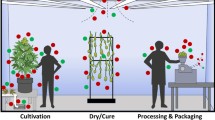Abstract
Toluene diisocyanate (TDI) is a volatile, highly reactive chemical widely used as a polymerizing agent in the production of polyurethane foams, lacquers, adhesives, and other items. Repeated airway exposures in the workplace to TDI may cause a concentration-dependent risk of developing chronic airway disorders. Different pathomechanisms are involved. IgE-mediated sensitization and irritative effects were clearly demonstrated in exposed subjects as well as in animals. In this study we examined the cellular and mediator composition in bronchoalveolar lavage fluid (BALF) of guinea pigs (eight in each group) exposed to TDI (10, 20, or 30 ppb) on 5 consecutive days for 2 hours each. Increased numbers of eosinophils and significantly elevated levels of LTB4 and LTC4/LTD4/LTE4 were obtained in BALF of all exposed animals when compared to nonexposed control animals. PGD2 and TXB2 remained unaltered in BALF. Stimulation of BALF cells of exposed and control animals with Ca-ionophore A23187 and arachidonic acid induced an increased generation of LTB4. Furthermore, BALF cells of the exposed animal groups generated immunoreactive LTC4/LTD4/LTE4, whereas controls did not show peptido-leukotriene formation in the presence and absence of stimuli. Our data clearly demonstrate an influx of eosinophils into the airways associated with mediator release and higher cellular responsiveness after TDI exposure.
Similar content being viewed by others
References
Baur X (1990) New aspects of isocyanate asthma. Lung (Suppl) 606–613
Bentley AM, Maestrelli P, Saetta M, Fabbri LM, Robinson DS, Bradley BL, Jeffery PK, Durham SR, Kay AB (1992) Activated T-lymphocytes and eosinophils in the bronchial mucosa in isocyanate-induced asthma. J Allergy Clin Immunol 89:821–829
Bradford MM(1976) A rapid and sensitive method for the quantitation of microgram quantities of protein utilizing the principle of protein-dye-binding. Anal Biochem 72:248–254
Coleridge HM, Coleridge JCG, Ginzel KH, Baker DG, Banzett RB, Morrison MA (1976) Stimulation of “irritant” receptors and afferent C-fibers in the lungs by prostaglandins. Nature 264:451–453
Dahlén S, Hansson G, Hedqvist P, Bjorck T, Granstrom E (1983) Allergen challenge of lung tissue from asthmatics elicits bronchial contraction that correlates with the release of leukotrienes C4, D4, and E4. Proc Natl Acad Sci USA 80:1712–1716
Erjefält I, Perrson CGA (1992) Increased sensitivity to toluene diisocyanate (TDI) in airways previously exposed to low doses of TDI. Clin Exp Allergy 22:854–862
Fabbri ML, Boschetto P, Zocca E, Milani G, Pivirotto F, Plebani M, Burlina A, Licata B, Mapp CE (1987) Bronchoalveolar neutrophilia during late asthmatic reactions induced by toluene diisocyanate. Am Rev Respir Dis 136:36–42
Ford-Hutchinson AW, Bray MA, Doig MV, Shipley ME, Smith MJ (1980) Leukotriene B, a potent chemokinetic and aggregating substance released from polymorphonuclear leukocytes. Nature 286:264–265
Goetzl EJ, Pickett WC (1980) The human PMN leukocyte chemotactic activity of complex hydroxyeicosatetraenoic acids (HETEs). J Immunol 125:1789–1791
Gordon T, Sheppard D, McDonald DM, Distefano S, Scypinski L (1985) Airway hyperresponsiveness and inflammation induced by toluene diisocyanate in guinea pigs. Am Rev Respir Dis 132:1106–1112
Hamel R, Ford-Hutchinson AW (1983) Bronchoconstrictor effects of leukotriene B4 in the guinea pig in vivo. Prostaglandins 25:405–412
Hesbert A, Ban M, Bonnet P, Simon P, Bottin MC, Lemonnier M, de Ceaurriz J (1991) Interdependence of polymorphonuclear neutrophils and macrophages stained for N-acetyl-β-glucosaminidase in lavage effluents from toluene diisocyanate-exposed rat lungs. Toxicol Lett 56:53–59
Holtzman MJ (1991) Arachidonic acid metabolism; implications of biological chemistry for lung function and disease. Am Rev Respir Dis 143:188–203
Ingenito EP, Pliss LB, Ingram RH, Pichurko BM (1990) Bronchoalveolar lavage cell and mediator responses to hyperpnea-induced bronchoconstriction in the guinea pig. Am Rev Respir Dis 141:1162–1166
Karaouglu K, Marek W, Potthast J, Marczynski B, Baur X (1992) Alteration of bronchial smooth muscle responses to acetylcholine by isocyanates in guinea pig trachea. Eur Respir J 5/15:271
Karol MH, Alarie YC (1978) Tolyl-specific IgE antibodies in workers with hypersensitivity to toluene diisocyanate. Am Ind Hyg Assoc J 39:454–458
Karol MH (1983) Concentration-dependent immunologic response to toluene diisocyanate (TDI) following inhalation exposure. Toxicol Appl Pharmacol 68:229–241
Kay AB (1991) Asthma and inflammation. J Allergy Clin Immunol 87:893–910
Mapp CE, Giacomo GR, Omini C, Broseghini C, Fabbri LM (1986) Late but not early, asthmatic reactions induced by toluene-diisocyanate are associated with increased airway responsiveness to methacholine. Eur J Respir Dis 69:276–284
Marczynski B, Czuppon AB, Marek W, Baur X (1992) Indication of DNA strand breaks in human white blood cells after in vitro exposure to toluene diisocyanate (TDI). Toxicol Ind Health 8:157–169
Marek W, Potthast J, Marczynski B, Baur X (1993) Alteration of smooth muscles responses acetylcholine induced by toluene diisocyanate (TDI) and neuropeptides in guinea pigs. Chiers voor Arbeitsgeneesekunde-Cahiers de Medecine du Travail vol. XXXL No 1–1994:45–47
Raulf M, König W (1991) Modulation of leukotriene release from human polymorphonuclear granulocytes by polychlorinated biphenyls (PCB). Immunology 73:485–490
Vandenplas O, Malo JL, Saetta M, Mapp CE, Fabbri LM (1993) Occupational asthma and extrinsic alveolitis due to isocyanates. Current status and perspectives. Br J Ind Med 50:213–228
Van Oosterhout AJM, Ladenius ARC, Savelkoul HFJ, Van Ark I, Delsman KC, Nijkamp FP (1993) Effects of anti-IL-5 and IL-5 on airway hyperreactivity and eosinophils in guinea pigs. Am Rev Respir Dis 147:548–552
Zocca E, Fabbri LM, Boschetto P, Plebani M, Masiero M, Milani GF, Pivirotto F, Mapp CE (1990) Leukotriene B4 and late asthmatic reactions induced by toluene diisocyanate. J Appl Physiol 68:1576–1580
Author information
Authors and Affiliations
Additional information
Results presented in the paper are part of the doctoral thesis of L. Tennie.
Rights and permissions
About this article
Cite this article
Raulf, M., Tennie, L., Marczynski, B. et al. Cellular and mediator profile in bronchoalveolar lavage of guinea pigs after toluene diisocyanate (TDI) exposure. Lung 173, 57–68 (1995). https://doi.org/10.1007/BF00167601
Accepted:
Issue Date:
DOI: https://doi.org/10.1007/BF00167601




